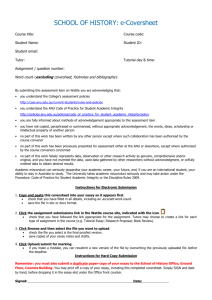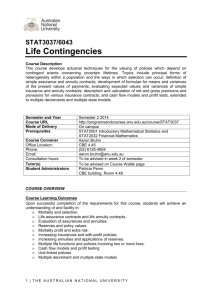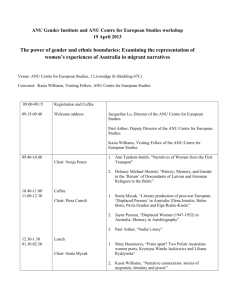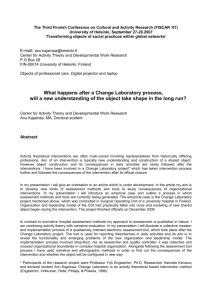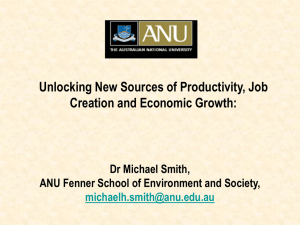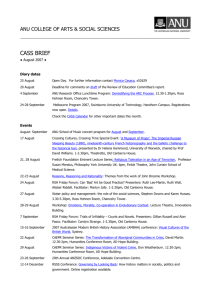Corporate Finance - ANU College of Business and Economics
advertisement
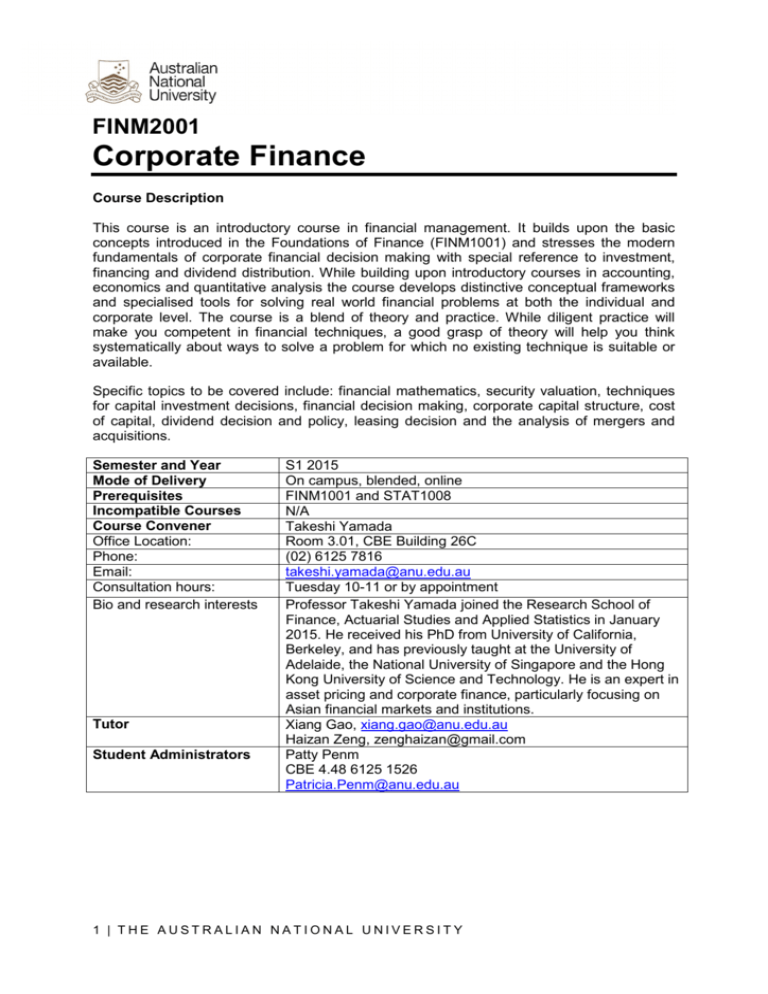
FINM2001 Corporate Finance Course Description This course is an introductory course in financial management. It builds upon the basic concepts introduced in the Foundations of Finance (FINM1001) and stresses the modern fundamentals of corporate financial decision making with special reference to investment, financing and dividend distribution. While building upon introductory courses in accounting, economics and quantitative analysis the course develops distinctive conceptual frameworks and specialised tools for solving real world financial problems at both the individual and corporate level. The course is a blend of theory and practice. While diligent practice will make you competent in financial techniques, a good grasp of theory will help you think systematically about ways to solve a problem for which no existing technique is suitable or available. Specific topics to be covered include: financial mathematics, security valuation, techniques for capital investment decisions, financial decision making, corporate capital structure, cost of capital, dividend decision and policy, leasing decision and the analysis of mergers and acquisitions. Semester and Year Mode of Delivery Prerequisites Incompatible Courses Course Convener Office Location: Phone: Email: Consultation hours: Bio and research interests Tutor Student Administrators S1 2015 On campus, blended, online FINM1001 and STAT1008 N/A Takeshi Yamada Room 3.01, CBE Building 26C (02) 6125 7816 takeshi.yamada@anu.edu.au Tuesday 10-11 or by appointment Professor Takeshi Yamada joined the Research School of Finance, Actuarial Studies and Applied Statistics in January 2015. He received his PhD from University of California, Berkeley, and has previously taught at the University of Adelaide, the National University of Singapore and the Hong Kong University of Science and Technology. He is an expert in asset pricing and corporate finance, particularly focusing on Asian financial markets and institutions. Xiang Gao, xiang.gao@anu.edu.au Haizan Zeng, zenghaizan@gmail.com Patty Penm CBE 4.48 6125 1526 Patricia.Penm@anu.edu.au 1 | THE AUSTRALIAN NATIONAL UNIVERSITY COURSE OVERVIEW Course Learning Outcomes By the end of this course, you should have developed basic knowledge and skills in analysing a range of real-life financial situation using the concepts, frameworks and theories learned throughout the course. These decisions problems include: 1. 2. 3. 4. 5. 6. 7. 8. 9. 10. consumption and investment decision under certainty; valuation of corporate securities; capital budgeting under certainty; capital budgeting under uncertainty; investment decisions; corporate capital structure decisions; dividend decisions and policy; capital raising decisions; leasing decisions; analysis of takeovers and mergers. Research-Led Teaching While students are not directly engaged in the research as part of the learning process, the course will cover significant materials including conference papers and journal articles that reflect the cutting edge research in the area of Corporate Finance. My aim is to integrate and emphasise how academic research can influence industry practice and policy making, and through these research works, students would be encouraged to think outside of the box. The course will also include parts which involve students in critical analysis of industrybased problems such as valuation, capital budgeting and risk assessments. Continuous Improvement We use feedback from students, professional bodies and staff to make regular improvements to the course. In response to this feedback, design improvements from the previous version of the course include: • Further incorporation of real-life case studies into the course materials. • More interaction between the lecturer and the students Technology, Software, Equipment A non-programmable scientific calculator is needed for every enrolled student in studying this course. It is students’ responsibility to learn how to use their calculators. Interactive tools embedded in WATTLE such as “Choice Activity” and “Feedback Activity” may be used to enhance interaction within and outside the class. The course will utilise McGraw-Hill Connect, which is a digital teaching and learning environment to further improve the learning experience and performance. Specifically, all online quizzes can be accessed through: http://connect.mheducation.com Student Feedback All CBE courses are evaluated using Student Experience of Learning and Teaching (SELT) surveys, administered by Planning and Statistical Services at the ANU. These surveys are offered online, and students will be notified via email to their ANU address when surveys are available in each course. Feedback is used for course development so please take the time to respond thoughtfully. Course feedback is anonymous and provides the Colleges, 2 | THE AUSTRALIAN NATIONAL UNIVERSITY University Education Committee and Academic Board with opportunities to recognise excellent teaching and to improve courses across the university. For more information on student surveys at ANU and reports on feedback provided on ANU courses, visit http://unistats.anu.edu.au/surveys/selt/students/ and http://unistats.anu.edu.au/surveys/selt/results/learning/ COURSE SCHEDULE Summary of Activities Required student preparation Week Online Assessment , Materials covered 1 Introduction to corporate finance Lecture Notes, Ch. 1-2 2 Time value of money, share and bond valuation Lecture Notes, Ch. 3-4 Quiz 1 Ch. 3-4 3 Project evaluation: principles and methods Lecture Notes, Ch. 5 Quiz 2 Ch 5 4 Application of project evaluation methods Lecture Notes, Ch. 6 Quiz 3 Ch 6 5 Sources of finance: equity & debt I Lecture Notes, Ch. 8-9 Quiz 4 Ch 8-9 6 Sources of finance: equity & debt II Lecture Notes, Ch. 10 Quiz 5 Ch 10 7 Portfolio theory and asset pricing Lecture Notes, Ch. 7 & Additional readings Midsemester Exam Mid-Semester Break: 6 April – 17 April (inclusive) 8 Dividends and share buyback decisions Lecture Notes, Ch. 11 & Additional readings Quiz 6 Ch 7 & 11 9 Principles of capital structure and capital structure decisions Lecture Notes, Ch. 12-13 Quiz 7 Ch 12-13 10 Cost of capital and taxation issues in project evaluation Lecture Notes, Ch. 14 Quiz 8 Ch 14 11 Leasing decisions Lecture Notes, Ch. 15 Quiz 9 Ch 15 12 Mergers and Acquisitions Lecture Notes, Ch. 19 & Additional readings Quiz 10 Ch 19 13 Review COURSE ASSESSMENT Assessment Summary Item Title Value Due Date 1 Online Quizzes 15% Online access open for one week 2 Mid-Semester Exam 20% Week 7 3 Final Exam 65% TBA 3 | THE AUSTRALIAN NATIONAL UNIVERSITY Assessment Task: Online Quizzes (Total Weighting 9×1.5% = 15%) Details of task: Students are required to sit 10 online quizzes. These quizzes will be open for access one week on the website provided by the textbook publisher. You must purchase the textbook that comes with CNCT (connect) with which you can only access the web materials used for weekly quizzes. Students are free to try as many times as you wish within a week and improve the scores. The relevant quiz will be opened for a week, starting immediately after the lecture and close before the following week’s lecture. For example, quiz 1 will start immediately after week 2 lecture and end just before week 3 lecture. Examinations Mid-semester Examination – 1.5 hours (Date: TBA, but will be in Week 7) Total weighting: 0% if the mid-semester exam is not attempted or it is redeemed in the final, or 20% if the exam is not redeemed in the final. The mid-semester is optional and redeemable. Specifically, if a student sits the midsemester exam, but gets a higher mark in the final exam, the final exam mark will count for 85% of the assessment, and the lower mid-semester exam mark will not count. More specific details regarding the time and location of the exam will be provided once they have been confirmed. The exam will test topics covered in Week 1 to Week 5 (inclusive). This is a closed book exam. Formula sheet will be provided. A mixture of theory and practical (numerical) questions will be asked. The marking criteria will be based on model solutions and answers prepared by the lecturer. The mid-semester exam is designed to: (i) measure how well students have synthesized the concepts learned in class; (ii) provide an opportunity to review the first five weeks of material which is critical for the remainder of the course; and (iii) provide feedback for lecturer and student on their progress for the course. There will be no special examination for the mid-semester exam. Instead the weighting will be moved to the final exam. Final Examination – 3 hours (Date: TBA) Total weighting; 85% if the mid-semester exam is redeemed, or 65% the mid-semester exam is not redeemed. This is a closed book exam with formula sheet. A mixture of theory and practical (numerical) questions will be asked. Students will need to review and revise all materials (weeks 1-13) pertaining to the course. Students will be provided with further details regarding the exam as it approaches. The marking criteria will be based on model solutions and answers prepared by the lecturer. Scaling 4 | THE AUSTRALIAN NATIONAL UNIVERSITY Your final mark for the course will be based on the raw marks allocated for each quizzes or examinations. However, your final mark may not be the same number as produced by that formula, as marks may be scaled. Any scaling applied will preserve the rank order of raw marks (i.e. if your raw mark exceeds that of another student, then your scaled mark will exceed or equal the scaled mark of that student), and may be either up or down. READING LISTS “Business Finance”, 12th Edition, by Peirson, Brown, Easton, Howard and Pinder You must purchase the above textbook that comes with CNCT (connect), which allows you to access the web materials used for weekly quizzes. (Total price $154.95). It is available from the Co-op store. Additional reading materials including journal articles, newspaper articles will be available on WATTLE. TUTORIAL AND/OR SEMINAR REGISTRATION Enrolment in tutorials will be completed online using the Electronic Teaching Assistant (ETA). To enrol, follow these instructions: 1. Go to http://eta.fec.anu.edu.au. 2. You will see the Student Login page. To log into the system, enter your University ID (your student number) and password (your ISIS password) in the appropriate fields and hit the Login button. 3. Read any news items or announcements. 4. Select "Sign Up!" from the left-hand navigation bar. 5. Select your courses from the list. To select multiple courses, hold down the control key. On PCs, this is the Ctrl key; on Macs, it is the key. Hold this key down while selecting courses with the mouse. Once courses are selected, hit the SUBMIT button. 6. A confirmation of class enrolments will be displayed. In addition, an email confirmation of class enrolments will be sent to your student account. 7. For security purposes, please ensure that you click the LOGOUT link on the confirmation page, or close the browser window when you have finished your selections. 8. If you experience any difficulties, please contact the School Office (see page 1 for contact details). COMMUNICATION The best way to contact me outside of class and consultation times is via the Wattle discussion board or email. If you have a question of a general nature, which may be of relevance to other students (e.g. questions about course content or assessments) then please use the Wattle discussion board. If your query is of a personal nature, then please use email. Please ensure that you send emails from your ANU email account. 5 | THE AUSTRALIAN NATIONAL UNIVERSITY Email If necessary, the lecturers and tutors for this course will contact students on their official ANU student email address. Information about your enrolment and fees from the Registrar and Student Services' office will also be sent to this email address. Announcements Students are expected to check the Wattle site for announcements about this course, e.g. changes to timetables or notifications of cancellations. Notifications of emergency cancellations of lectures or tutorials will be posted on the door of the relevant room. Course URLs More information about this course may be found on: • Programs and Courses (http://programsandcourses.anu.edu.au/2014/Catalogue) • the College of Business and Economics website (http://cbe.anu.edu/courses) and • Wattle (https://wattle.anu.edu.au), the University's online learning environment. Log on to Wattle using your student number and your ISIS password. POLICIES The University offers a number of support services for students. Information on these is available online from http://students.anu.edu.au/studentlife/ ANU has educational policies, procedures and guidelines, which are designed to ensure that staff and students are aware of the University’s academic standards, and implement them. You can find the University’s education policies and an explanatory glossary at: http://policies.anu.edu.au/ Students are expected to have read the Student Academic Integrity Policy before the commencement of their course. Other key policies include: • • Student Assessment (Coursework) Student Surveys and Evaluations 6 | THE AUSTRALIAN NATIONAL UNIVERSITY Diagrammatic outline of the course Lecture 1: Overview of corporate finance decisions and the underlying theory (Fisher’s Separation Theorem) Lectures 2 – 4: Time value of money; Share, bond & project valuation Investment decision Lecture 7: Portfolio theory and asset pricing Lecture 12: Mergers & Acquisitions Lectures 5 & 6: Equity & debt financing Financing decision Dividend decision Lectures 9: Theory of capital structure & its application Lectures 11: Leasing decision Lecture 8: Dividends & share repurchases Lecture 10: Cost of Capital 7 | THE AUSTRALIAN NATIONAL UNIVERSITY
